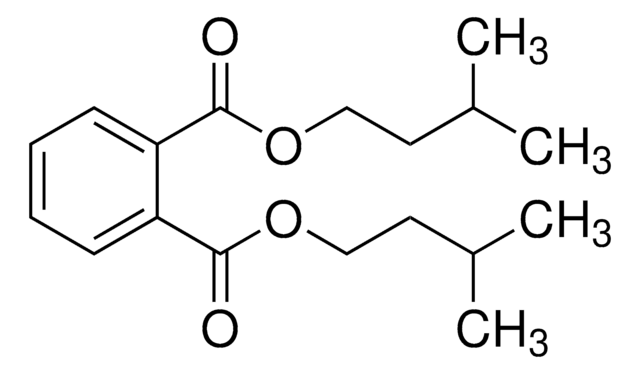49617
Dihexyl phthalate
analytical standard
Synonym(s):
1,2-Benzenedicarboxylic acid 1,2-dihexyl ester, Di-n-hexyl phthalate, Phthalic acid dihexyl ester
About This Item
Recommended Products
grade
analytical standard
Quality Level
Assay
≥99.0% (GC)
shelf life
limited shelf life, expiry date on the label
technique(s)
HPLC: suitable
gas chromatography (GC): suitable
refractive index
n20/D 1.486-1.489
application(s)
cleaning products
cosmetics
environmental
food and beverages
personal care
format
neat
storage temp.
2-8°C
SMILES string
O=C(OCCCCCC)C1=CC=CC=C1C(OCCCCCC)=O
InChI
1S/C20H30O4/c1-3-5-7-11-15-23-19(21)17-13-9-10-14-18(17)20(22)24-16-12-8-6-4-2/h9-10,13-14H,3-8,11-12,15-16H2,1-2H3
InChI key
KCXZNSGUUQJJTR-UHFFFAOYSA-N
Related Categories
General description
Application
Recommended products
Signal Word
Danger
Hazard Statements
Precautionary Statements
Hazard Classifications
Repr. 1B
Storage Class Code
6.1C - Combustible acute toxic Cat.3 / toxic compounds or compounds which causing chronic effects
WGK
WGK 3
Flash Point(F)
350.6 °F
Flash Point(C)
177 °C
Regulatory Listings
Regulatory Listings are mainly provided for chemical products. Only limited information can be provided here for non-chemical products. No entry means none of the components are listed. It is the user’s obligation to ensure the safe and legal use of the product.
FSL
Group 4: Flammable liquids
Type 3 petroleums
Hazardous rank III
Water insoluble liquid
ISHL Indicated Name
Substances Subject to be Indicated Names
ISHL Notified Names
Substances Subject to be Notified Names
JAN Code
49617-VAR:
49617-BULK:
49617-250MG:
Choose from one of the most recent versions:
Already Own This Product?
Find documentation for the products that you have recently purchased in the Document Library.
Customers Also Viewed
Our team of scientists has experience in all areas of research including Life Science, Material Science, Chemical Synthesis, Chromatography, Analytical and many others.
Contact Technical Service










